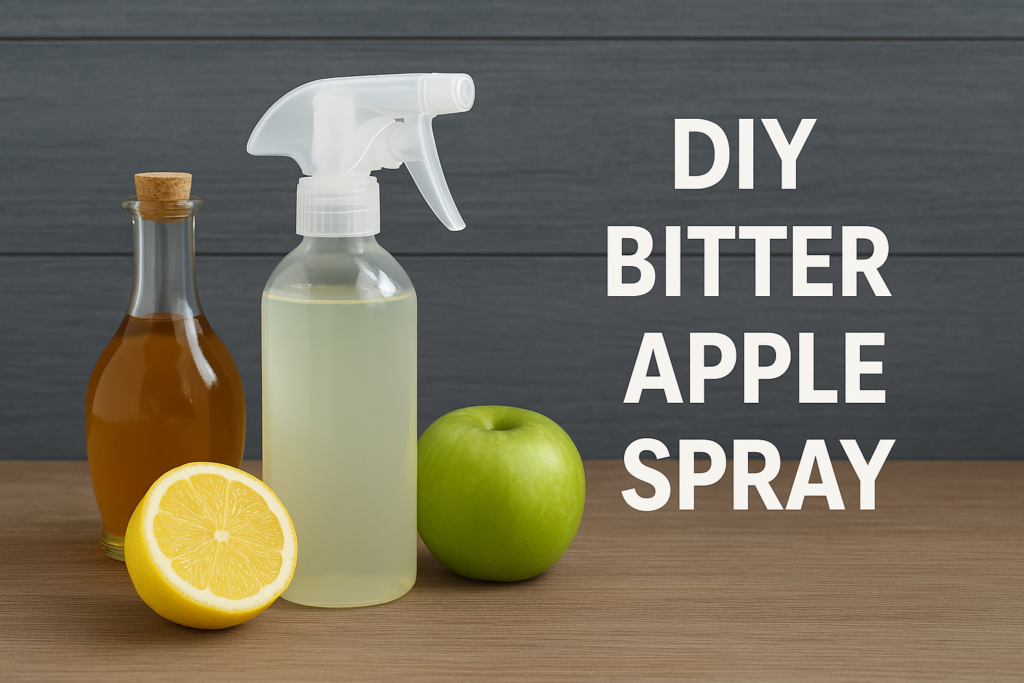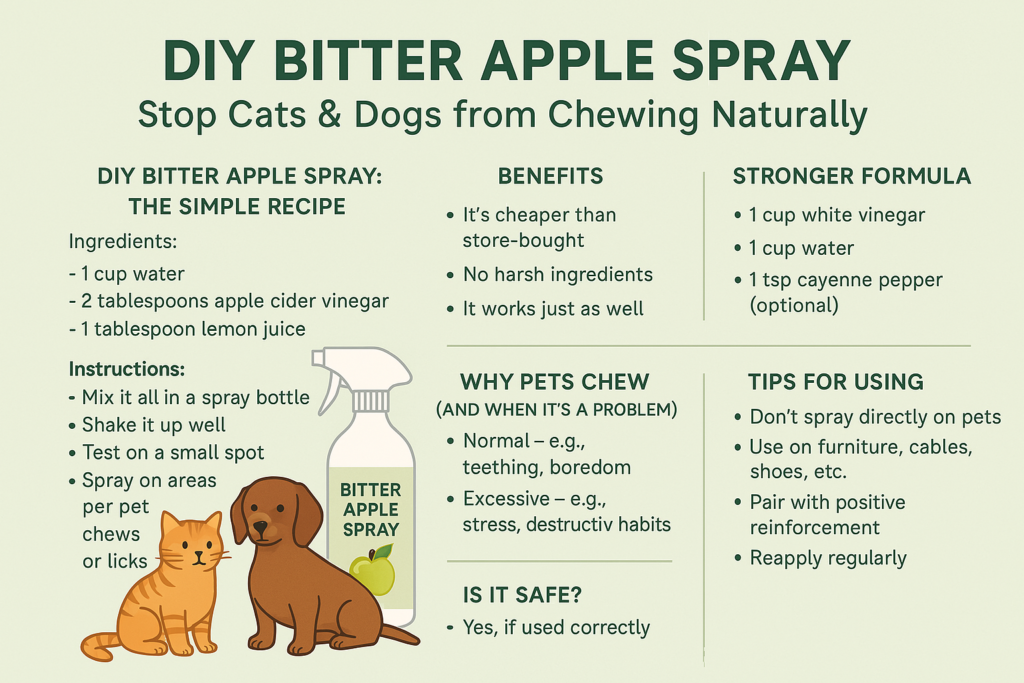Diy Bitter Apple Spray is a non-toxic, harmless deterrent that prevents pets, particularly dogs and cats, from chewing on furniture, shoes, cables, and even their own wounds. The harsh, unpleasant flavor immediately prevents repeated nibbling or licking. Originally marketed as a commercial product, many pet owners choose to make their own at home.
The virtue of bitter apple spray is its simplicity. It does not harm the animal; it simply tastes bad enough to discourage undesirable behavior. DIY alternatives are just as effective and less expensive, making them a popular choice among responsible pet parents.
Why Do Pets Chew?
Chewing is a normal behavior in dogs and cats, but it can become harmful. Puppies chew during teething to relieve discomfort, while adult dogs may chew out of boredom, anxiety, or curiosity. Cats may lick or bite surfaces to explore or mark their territory.
Excessive chewing is typically indicative of an underlying problem. It could indicate stress, a lack of excitement, or even a medical issue. Understanding the source of chewing can help establish whether a DIY bitter apple spray is a viable remedy or part of a bigger behavioral strategy.
Benefits Bitter Apple Spray
Making your possess severe apple splash offers different benefits. For starters, it is sensibly estimated. Commercial splashes can be costly, but non-stop utilization may require a few bottles. DIY showers utilize reasonable family chemicals, which spares you cash in the long term.
Second, you pick up control over the equation. A few commercial items contain liquor or additives, which can cause disturbance in delicate pets. Making your possess shower guarantees that it is secure, new, and particularly customized to your pet’s needs.
Ingredients Used in DIY Bitter Apple Sprays

A DIY bitter apple spray doesn’t require favor or uncommon fixings. The foremost common components are apple cider vinegar, lemon juice, white vinegar, fundamental oils, and water. These fixings are effectively found in most kitchens and are by and large secure for pets.
Apple cider vinegar is the essential bittering operator. Its solid acrid taste and fragrance actually repulse most pets. Lemon juice too includes a sharp tang and boosts the scent obstruction. A few pet proprietors include a drop of secure fundamental oils like tea tree or eucalyptus (in little sums) for included viability.
Recipe
Making your own bitter apple spray is quick and simple. Here’s a basic recipe that works well for most pets:
Ingredients:
- 1 cup of water
- 2 tablespoons of apple cider vinegar
- 1 tablespoon of lemon juice
Instructions:
- Mix the water, vinegar, and lemon juice in a spray bottle.
- Shake well to combine.
- Test the spray on a small fabric area to ensure it doesn’t stain.
- Spray on items your pet tends to chew.
Use this spray consistently, particularly in the early preparation stages. Reapply every few days or after cleaning the treated surface.
Alternative Bitter Spray Recipes
If your pet gets used to the basic formula or doesn’t respond to it, try stronger versions. Here’s an alternative bitter spray recipe:
Strong Bitter Apple Alternative:
- 1 cup of white vinegar
- 1 cup of water
- 1 teaspoon of cayenne pepper (optional for strong chewers)
Mix thoroughly and apply to the damaged regions. The vinegar and cayenne combination makes a very potent repellent, but it should be used with caution. Always test a small patch first and never spray directly on your pet’s wounds or body.
Is DIY Safe for Pets?
Yes, when applied correctly, most homemade bitter apple sprays are absolutely safe for pets. Vinegar and lemon juice are non-toxic when consumed in tiny amounts. However, do not spray near your pet’s eyes, nose, or sensitive skin parts.
Always keep track of your pet’s reaction after using the spray. If they exhibit irritation, sneezing, or excessive salivation, discontinue use and consult a veterinarian. Also, avoid using essential oils in high concentrations, as some can be toxic to pets.
When and Where to Use
The spray works best on furniture, shoes, cables, and other household items that your pet likes to chew. Some pet owners also use it around baseboards and in the corners of couches. In some situations, it can be applied to bandages or pet clothing to prevent wound licking.
The spray should be applied on a frequent basis, particularly throughout the training phase. Consistency is essential. Pair the spray with positive reinforcement—reward your pet when they avoid chewing the treated item—to accelerate learning.
How Often Should You Reapply?

DIY sprays, particularly ones without preservatives, do not last as long as commercial products. Reapply every 2-3 days, or after cleaning the treated object. If your pet is a persistent chewer, daily treatment may be required at first.
Keep an eye on the surface of the sprayed item. If you spot your pet eating it again, it’s time to apply a fresh coat of spray. As your pet learns the boundaries, progressively lower the frequency.
Tips
Combining bitter apple spray with fundamental training techniques will increase its effectiveness. Redirect your pet’s chewing to more appropriate toys. When they select the correct thing, reward them with praise or treats. This tells kids what is appropriate.
Also, try not to spray everything in the house—focus on the problem areas. Excessive spraying may desensitize your pet to the taste or make your house smell bad. Begin small, remain consistent, and be patient.
DIY Spray for Cats
Cats can be more difficult to teach, and their noses are sensitive. When manufacturing cat spray, utilize softer components. Many powerful essential oils are hazardous to cats, so avoid using them.
Try this milder cat-friendly formulation:
1 cup of water
1 tablespoon of apple cider vinegar
1 teaspoon of lemon juice
Shake and apply to areas where your cat tends to scratch or chew. Always observe your cat’s behavior after use and adjust the formula if necessary.
DIY Spray for Dogs
Because of their keen sense of taste, dogs respond effectively to bitter sprays. If your dog is chewing on shoes, wires, or furniture legs, this spray can help break the habit.
You can use the basic recipe or a stronger version if your dog is really tenacious. Apply daily and provide chew toys as a substitute. Your dog will eventually learn that chewing particular items produces an undesirable flavor.
How to Store Homemade Spray
Because DIY sprays contain no preservatives, they may not last indefinitely. Store your spray in a dark, cool location, preferably in a labeled spray bottle with a tight top.
Shake thoroughly before each use, and dispose of any unused spray after 2-3 weeks. If the spray begins to smell odd or changes color, make a new batch.
Common Mistakes to Avoid
Avoid spraying too close to your pet or directly on their body unless it’s a vet-approved formula. Also, don’t abuse the spray in areas that don’t need it—it could cause misunderstanding or create a terrible environment.
Another mistake is to apply bitter sprays without addressing the underlying cause of chewing. If your pet is stressed or bored, no spray will completely eliminate the habit. Ensure that your pet receives adequate exercise, stimulation, and affection.
Can You Use Bitter Apple Spray on Skin?
Some pet owners try to prevent their pets from licking wounds or stitches by spraying bitter apple onto their skin. This should only be done with veterinary supervision. While vinegar-based sprays are natural, they can hurt or irritate exposed wounds.
Instead, apply vet-recommended wound protectants or cover the area with pet clothes or e-collars. The goal is to cure the wound safely, not only to prevent licking.
Seek Professional Help
If your pet continues to chew destructively despite deterrents such as bitter apple spray, it may be time to seek expert help. Veterinarians and animal behaviorists can assist in identifying more serious disorders such as anxiety or nutritional deficits.
A few pooches endure from partition uneasiness, whereas a few cats show over the top chewing due to stretch. In such cases, a all encompassing approach counting preparing, count calories changes, and natural enhancement will be more compelling than any splash.
Conclusion
DIY bitter apple spray is an easy, inexpensive, and effective way to preserve your valuables and control your pet’s behavior. While it may not be a cure-all, it is an excellent first step toward controlling chewing behaviors, especially when combined with patience and positive reinforcement.
Just remember that consistency, safety, and understanding your pet’s requirements are critical. With a little effort and affection, your puppy can learn good habits while your furniture remains intact.
Read more blogs related to this topic

